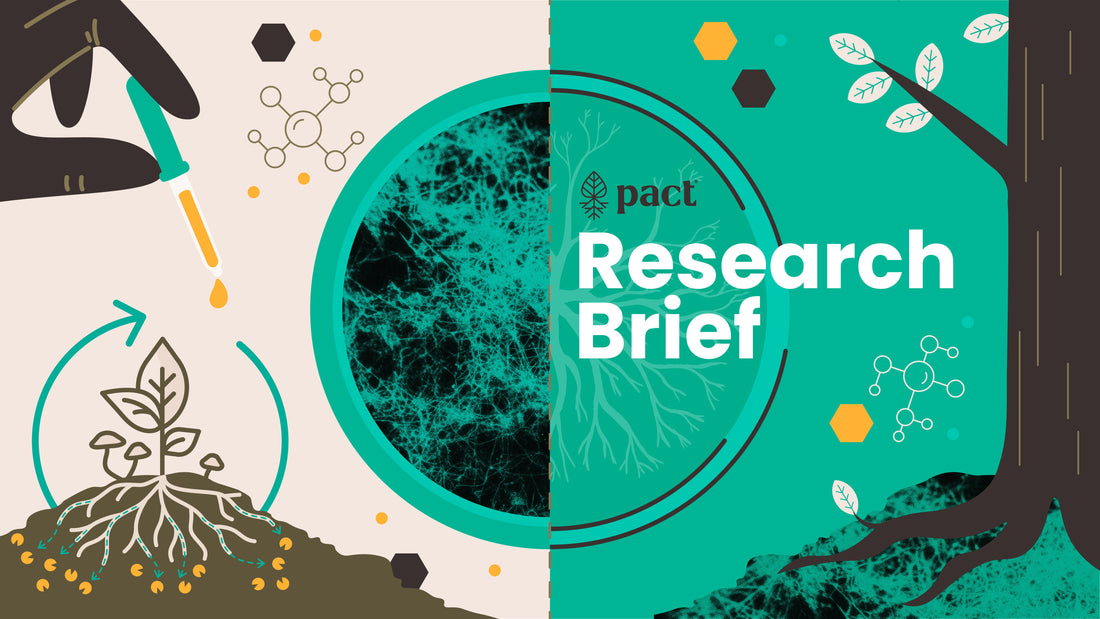
Why Use Mycelium To Break Down Poop In The Backcountry?
Share
American Participation in Outdoor Recreation Continues to Grow
According to an Outdoor Industry Association (OIA) annual report, participation in outdoor recreation continued to grow in 2024 to a record-breaking 181.1 million people or almost 60 percent of Americans six and older.
This growing participation has many effects. Among them is more people pooping in the outdoors whether at a trailhead toilet or in the backcountry. Although we expect users to be prepared with the necessary tools to follow Leave No Trace Principles when going to the bathroom, many are not.
In 2020, PACT conducted a survey among outdoor enthusiasts. The survey, which inquired about people’s backcountry bathroom behaviors, received over 25,000 responses, making it the largest survey on backcountry bathroom behavior ever conducted. In this survey we found that 72% of outdoor enthusiasts across ages, activities and experience levels have had a time when they were in the outdoors, beyond the reach of a bathroom, and had to poop, but didn’t have the tools to handle it responsibly or in accordance with Leave No Trace practices.
In a separate study with Penn State University, Leave No Trace, the U.S. Forest Service and Colorado Fourteeners Initiative, pack out poop behavior was studied at Mt. Elbert, Colorado’s tallest 14,000’ peak. Data collected over the three week study found that 70% of hikers who were pooping during their hike were doing so beyond the reach of the trailhead vault toilet. In other words, they were pooping somewhere along the trail, necessitating that they bring proper tools, including a “WAG Bag” given the alpine environment. The data from this study is still undergoing analysis and review, and will be published by researchers from Penn State University.
Out of all the survey respondents in the study who pooped during their hike, only one person arrived at the trailhead with a WAG Bag/Pack Out Kit.
To summarize, more and more people are heading into the outdoors; significant numbers of people are failing to bring the necessary tools for responsible waste management; and at least in certain contexts, the majority of the pooping behavior is happening beyond the reach of permanent trailhead facilities.
Mis-Handled Human Poop Has Many Negative Impacts
Animals have been pooping outside for thousands of years. So, why is human poop a problem? Human poop is much more toxic than animals because people eat a different diet than animals. The things we eat, including refined sugars, preservatives, alcohol, prescription medications, meat and other processed foods, cause harmful bacteria to grow in our gut. Humans are also exposed to a far greater variety of bacteria and viruses than animals in the wild. Many of the viruses and bacteria that we carry within us are sustained within our waste, and when we poop in the wilderness, it can end up in the soil, causing harm to the surrounding environment, wildlife, and people who recreate and work in these places.
There is an ever-growing body of research surrounding the effects of mis-handled human waste in the backcountry. The bacterial pathogens in human poop can remain active in the soil for over a year (Goodwin et al. 2012). Fecal bacteria like E. coli in human waste contaminates waterways and can persist for at least a year in the environment (Derlet et al. 2008) leading to gastrointestinal diseases and other issues (Boulware 2004). Animals can become habituated to human waste leading to behavioral changes (Daszak et al. 2000). Mis-handled poop can also affect soil health via the nutrient cycling process (Craine et al. 2007).
In addition, the sight of improperly disposed human waste significantly reduces visitor satisfaction, even more so than overcrowding (USFS, 2020). Similarly, a study done by Elli Morris, a former Northern Arizona University graduate student and National Forest Foundation Research Fellow, still in the review stage, found that 75% of respondents would not return to a wilderness area if they found used toilet paper between one and three times.
The effects of human waste have been documented in world-renowned outdoor recreation destinations ranging from the Appalachian Trail (Reed, 2016) to Mount Everest.
As a result of the volume of mis-handled waste in the outdoors, and the affects above, land managers across the U.S. are responding by restricting access to public lands in a variety of ways. For example, they are reducing dispersed camping sites; they are converting unpermitted locations to permitted; they are reducing the number of permits issued in a given area; and instituting timed entry systems. In all of these instances, mis-handled human waste is a top reason for these changes. While arguably essential for addressing issues with over-use, these changes can make outdoor access more challenging particularly for newer entrants.
How Mycelium & Mycoremediation Can Help
The microbes in the soil that help to decompose poop are often unable to keep up with buried or surface level waste (Bridle 2004). Why? Ecosystems, particularly across the U.S., have very different environmental conditions that impact soil microbe activity.
A growing body of work supports mycoremediation: the use of fungi to solve soil pollution problems (Harms 2011). Fungi are nature’s recyclers and upcyclers. They link ecosystems and organisms (Bahram 2022) and certain types have unique potential to break down both organic and inorganic pollutants, converting them into bioavailable nutrients for the soil.
Different species of fungi from across the kingdom have been shown to break down various pollutants spanning explosives to pesticides and PCBs (Harms 2011). For example:
- The EPA funded work by Paul Stamets to investigate filtering out E. coli from water runoff after a rain storm (Stamets, 2013).
- Others have looked at mycelium as a means to reduce pathogens from wastewater lagoons. Researchers at the University of New Mexico, together with the city of Albuquerque, looked at using floating filters using oyster mushrooms. They found that the filters reduced surface level E. coli reliably, week after week (Martinez, 2016).
- The Dungeness watershed built a wetland to treat cow manure and incorporated a layer of mycelium with wood-like supplements to help it grow and the fungi (a trio of Pleurotus ostreatus, Pleurotus ulmarius, and Stropharia rugosoannulata) helped to consistently remove E. coli.
Stropharia rugosoannulata, the species of fungi used in PACT Tabs, has been studied extensively for its potential for bioremediation of soils. S. rugosoannulata has the incredible ability to break down various environmental pollutants, not just plant matter, in both soil and water. Its lignin modifying enzymes (LME) for wood decomposition are not highly specialized (i.e. limited to wood), allowing them to degrade various other compounds as well.
S. rugosoannulata is able to degrade “a wide range of structurally different environmental pollutants such as polycyclic aromatic hydrocarbons (PAHs), cancer-causing byproducts of fossil fuel burning (Pozdnyakova, et. al., 2018). White-rot fungi, which includes S. rugosoannulata, are also known to remove pharmaceutical-derived pollutants and antibiotics. PACT Outdoor’s research with Colorado Mountain College as well as the examples above continues to show S. rugosoannulata’s ability to remove bacterial pathogens like E. coli while accelerating the breakdown of human waste in the outdoors. We will talk about this in greater depth in our other briefs.
S. rugosoannulata is also extremely beneficial to soils. When used as a soil additive in forestlands, it is correlated with a consistently higher abundance of good bacteria like Acidobacteria, Planctomycetes and Bacteroidetes that support the decomposition of organic matter, as well as carbon and nitrogen cycles. This demonstrates S. rugosoannulata’s positive impact on the organic matter and abundance/diversity of good soil bacteria (Gong, et. al., 2018).
Next Steps
When we talk about decomposing human waste in the outdoors, we’re really interested in eliminating pathogens like E. coli that can persist in the soil, contaminate waterways, harm wildlife and spread disease.
Until we began our own research, S. rugosoannulata’s ability to remove E. coli bacteria from contaminated soil or water had been studied, but was still quite new. A forthcoming study led by Colorado Mountain College is still in the review phase but demonstrates tremendous potential for S. rugosoannulata’s capacity to remove human coliform bacteria from human waste. This will also be addressed in future research briefs.
Bibliography
-
Bahram M, Netherway T. Fungi as mediators linking organisms and ecosystems. FEMS Microbiol Rev. 2022 Mar 3;46(2):fuab058. doi: 10.1093/femsre/fuab058. PMID: 34919672; PMCID: PMC8892540. - LINK
-
David R. Boulware, Influence of Hygiene on Gastrointestinal Illness among Wilderness Backpackers, Journal of Travel Medicine, Volume 11, Issue 1, 1 January 2004, Pages 27–33, - LINK
-
Craine JM, Morrow C, Fierer N. Microbial nitrogen limitation increases decomposition. Ecology. 2007 Aug;88(8):2105-13. doi: 10.1890/06-1847.1. PMID: 17824441. - LINK
-
David R. Boulware, Influence of Hygiene on Gastrointestinal Illness among Wilderness Backpackers, Journal of Travel Medicine, Volume 11, Issue 1, 1 January 2004, Pages 27–33, - LINK
-
Daszak P, Cunningham AA, Hyatt AD. Emerging infectious diseases of wildlife--threats to biodiversity and human health. Science. 2000 Jan 21;287(5452):443-9. doi: 10.1126/science.287.5452.443. Erratum in: Science 2000 Mar 10;287(5459):1756. PMID: 10642539. - LINK
-
Derlet RW, Ali Ger K, Richards JR, Carlson JR. Risk Factors for Coliform Bacteria in Backcountry Lakes and Streams in the Sierra Nevada Mountains: A 5-Year Study. Wilderness & Environmental Medicine. 2008;19(2):82-90. doi:10.1580/07-WEME-OR-1511.1 - LINK
-
Gong S, Chen C, Zhu J, Qi G, Jiang S. 2018. Effects of wine-cap Stropharia cultivation on soil nutrients and bacterial communities in forestlands of northern China. PeerJ 6:e5741 - LINK
-
Goodwin, K., Loso, M. G., & Braun, M. (2012). Glacial Transport of Human Waste and Survival of Fecal Bacteria on Mt. McKinley’s Kahiltna Glacier, Denali National Park, Alaska. Arctic, Antarctic, and Alpine Research, 44(4), 432–445. - LINK
-
Harms H, Schlosser D, Wick LY. Untapped potential: exploiting fungi in bioremediation of hazardous chemicals. Nat Rev Microbiol. 2011 Mar;9(3):177-92. doi: 10.1038/nrmicro2519. Epub 2011 Feb 7. PMID: 21297669. - LINK
-
Martinez, Savannah E.. "E. Coli Removal by Pleurotus Ostreatus Mycofilter in Simulated Wet Environmental Pond." (2016) - LINK
-
Paul Stamets, Marc Beutel, PhD., Alex Taylor, Alicia Flatt, Morgan Wolff, Katie Brownson. Mycofiltration Biotechnology for Pathogen Management. Fungi Perfecti’s EPA SBIR Phase I Research Results. 2013. - LINK
-
Pozdnyakova, N., Schlosser, D., Dubrovskaya, E. et al. The degradative activity and adaptation potential of the litter-decomposing fungus Stropharia rugosoannulata. World J Microbiol Biotechnol 34, 133 (2018). - LINK
-
Reed BC, Rasnake MS. An Assessment of Coliform Bacteria in Water Sources Near Appalachian Trail Shelters Within the Great Smoky Mountains National Park. Wilderness Environ Med. 2016 Mar;27(1):107-10. doi: 10.1016/j.wem.2015.09.019. Epub 2015 Dec 7. PMID: 26674141. - LINK
- U.S. Forest Service National Visitor Use Monitoring Survey Results National Summary Report 2020 - LINK
